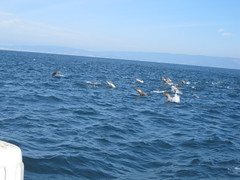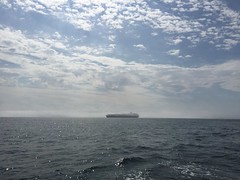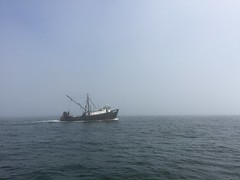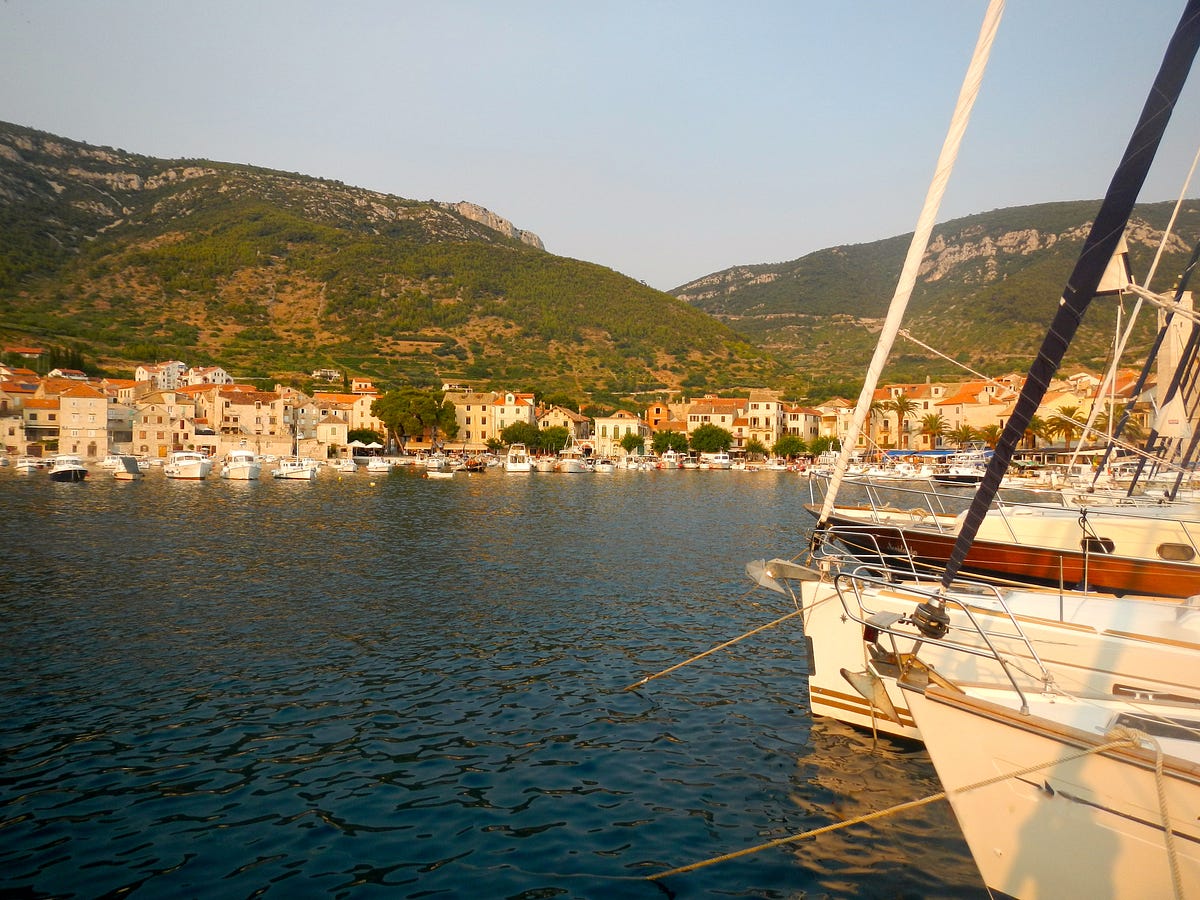
Med moored with the fleet in Komiža, island of Vis.
CRUISING CROATIA – Peggy Droesch
It’s been four years since our last charter: Rory and I were overdue for another. We were already going to be in Italy with our old sailing buddies Craig & France, so scheduling a charter in Croatia was an intriguing add-on. In the last decade of the 20th century the Yugoslav wars, including the Croatian War of Independence, shattered this coast into half a dozen independent states. None of us have ever visited a country living so close to the aftermath of war; it will be interesting to see how the people and the places have recovered twenty years on.
The Moorings base is in the village of Marina, 30 km west of the old Dalmatian city of Split. An overnight ferry from Italy got us to Split early on the morning our charter was to start. Most charterers arrive at the airport a few km away from the base, but Moorings arranged a shuttle to pick us up from the ferry terminal. Now, about provisioning…
For our last charter in Belize, we used the full-provisioning plan (3 meals a day for 7 days, times 4 people, equals 84 servings), which was less than ideal. First of all, their US-centric menus often have little or no basis in cruiser reality (somebody thinks I’m going to fire the oven for an hour in high summer, on a boat with no AC? Get a grip). More to the point, it was way more food than we could eat, so much so that we ended up giving about a third of it away to a local family. Charitable giving is a good thing & I am all for it, but seriously?! I was determined to do the provisioning myself and buy only what we needed.
From what we had read about cruising in Croatia, it was clear that dining out was going to be the order of the day for most of our lunches and dinners. So, after poring over the Moorings provisions lists and browsing their online market, I settled on a personalized plan. Have them deliver the basics: breakfast foods (eggs, bacon, muesli); condiments; a few snacks; the starting point for a couple of simple dinners (rice, pasta); and the heavy stuff (drinking water, beer, wine). Then, hit up a market for fresh food, and embrace the notion of eating like a local!
Armed with a list and a few shopping bags, France and I headed off to the market across the street while the guys did the captain’s briefing. In a small park nearby was a produce stand, so we took a good look at what they had before going into the market. Inside, we bought fresh chicken, Dalmatian ham and prosciutto, local cheeses, yogurt, breads, crackers and a jar of something that might be pasta sauce, except I don’t know enough Croatian to read the label; but the picture looks promising, it’ll be fun to find out what it is! On our way back to the boat, the produce stand: tomatoes, garlic, grapes, cucumbers, melons, peaches, lemons, limes…
This worked very well. In every town we stopped, there were plenty of shops nearby to pick up whatever else we might need; and finding a café on the waterfront for coffee and pastries became an early-morning habit. It was especially fun to browse through farmer’s markets and bakeries; and the tiny brick-&-mortar markets (Studenac and Tommy Market were two chains we learned to look for) were always an education.

The only real fail on my provisions list was drinking water. I ordered what Moorings considered “essential” for 4 people (a dozen 1.5-liter bottles), but it was nowhere near enough in the heat of July — we bought another 24 bottles over the course of the week. [Before you ask, the water in the tanks waspotable. Nominally.] And of course, the one case of Karlovačko beer that I ordered wasn’t going to last more than a day or two; but it was just as much fun to see what local brew was on offer at each town! I honestly regretted ordering more than a bottle or two of wine from the charter company, because vineyards are everywhere in Croatia: the big islands we stopped at had at least one winery within motor scooter distance, whose wares you could sample and buy; and every town had at least one good wine shop.
Our boat Carina was a Beneteau 42.3, double helm, 3 cabin, 2 head, rated for up to 8 people. Comfortable for 4 adults and maybe a couple of kids, but I can’t imagine trying to cram any more bodies onboard than that! On Carina, the portside aft cabin was for stowage: 4 sets of luggage, unneeded clothes, cases of water, cases of beer. Craig and France got the vee berth because it’s got more room to move around in and better ventilation. Plus, it’s a better cabin to be in if you like to sleep in — you’re all the way forward, so the early risers can rattle around the saloon or the cockpit without bothering you any more than necessary. Rory and I, early risers both, took the starboard aft cabin that connects directly to the larger of the two heads. A little cramped & stuffy, but we can live with it for a week, and how much time are we going to spend below decks anyway?
Day 1: Marina to Solinska Bay, Drvenik Veli: 43° 26′ 7.32″ N, 16° 8′ 52.04″ E
One of the departing charterers told us about a great spot for the first night’s anchorage: protected bays, you can get a good set on the hook well before sundown, take a dip and relax… the island of Drvenik Veli. Once out of the deep inlet that Marina is nestled into, a lovely beam-reach sail to get there; and Solinska Bay was everything he claimed and more. I found it hard to believe that the Adriatic Sea could be as warm as the Caribbean — it is at least 20 degrees of latitude farther north, after all — but it’s as warm as any place in the tropics that we have ever been. Swimming in this balmy clear water is sheer heaven. And the hills around us are fascinating: covered with an endless web of ancient dry stone walls enclosing — what? Grapevines and olive trees? Livestock? Or were they built just to get all those rocks out of the way? All of the above, probably. A staggering amount of work by a long-dead people, before our very eyes…

There were a handful of boats already anchored for the night, so we dropped the hook a reasonable distance away. Our nearest neighbor was a German flagged boat, with a crew who, like many Germans, were very comfortable in their own skin. Which is to say, they liked to hang out in the buff. So we took to calling everything we did without benefit of clothing, German fill-in-the-blank. “Hey guys! nice deserted cove, time for some German swimming!” “Eyes forward, I’m going to take a German shower off the transom!” A sly wink at my heritage! Our only other close company was a fishing family who tended nets in their skiff, well into the evening and at first light too.
Day 2: Drvenik Veli to Vela Travna, island of Vis: 43° 1′ 10.04″ N, 16° 10′ 42.25″ E
Very light air & a long way to go: we leave at dawn. We stopped at the town of Vis on the north side of the island long enough to have a late lunch and pick up a few things at the market; but elected to look for an overnight anchorage on the sparsely-populated southern shore. Vela Travna is a tiny bay, whose equally tiny settlement has the distinction of housing a restaurant run by a well-known local author. [Even famous authors need a sideline.] No swinging room in this narrow place, so we had to set a stern line on shore. Which in practice meant, load the dink with our secondary anchor, clamber up a jagged wall of rock and find a place to drop the Danforth so that it will dig in behind a ledge and hold all night.
I wasn’t hungry — my shrimp salad at lunch was huge — so I decided to stay on board and keep an eye on the stern line while the rest of the crew went ashore for dinner. In spite of the bobbing and weaving normal to an anchorage at sunset, it is holding fast; we’ll sleep soundly tonight.
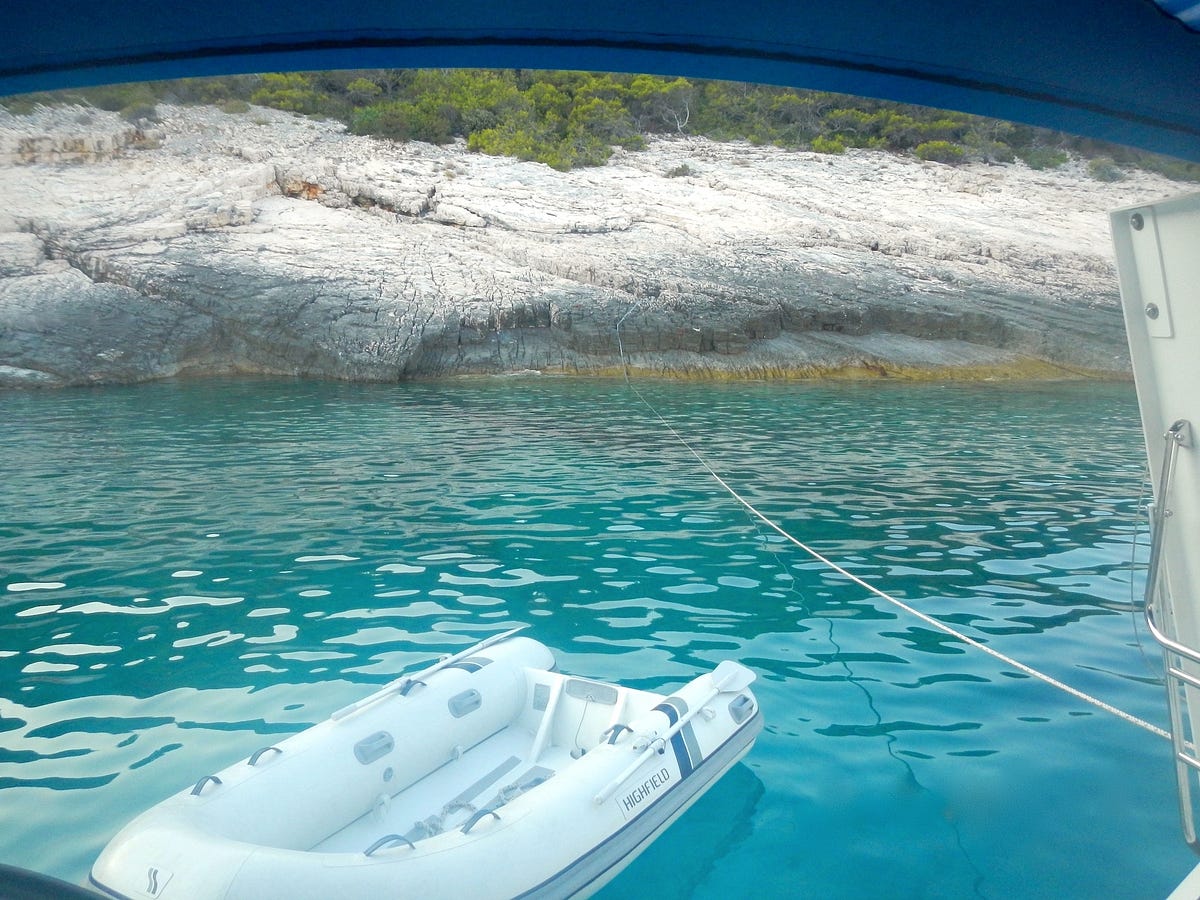
Days 3 & 4: the quay at Komiža, island of Vis: 43° 2′ 39.45″ N, 16° 5′ 13.33″ E
Oh brother, here it comes: the dreaded Med moor. Craig and France had taken an advanced anchoring class before a charter in Greece, and we all knew the technique in theory: circle the harbor, choose your spot, drop the hook and set it, power in reverse to the quay, tie off your stern lines, snug up the bow and you’re in. But knowing what kind of crowds we would be dealing with in high summer (most of whom have more experience Med-mooring than we do) had me, at least, a little nervous: should we practice before we leave San Francisco? what do we do if we screw up, because being stupid Americans who are used to docking in between fingers or at an end tie at the very least, we will… OMG OMG OMG.
Not to worry: all the harbors we saw have it down to a system that is as easy as it gets. You motor slowly in; there is a Harbor Guy on the quay waving you to the space he wants you to back to, and in some cases, a second Harbor Guy in a RIB ready to assist from the water. You back to the quay with your windward stern line pre-set; hand it to the shoreside Harbor Guy, who loops it through a ring and gives it back to you to cleat off. Then he hands you a small line which, wonder of wonders, is attached to a laid mooring line which you pull up from the water as you walk forward: snug it up and cleat off at the bow. Snug up another stern line to leeward, set the gangplank and bingo, you’re done. This is easy!! Laid lines are undoubtedly a lot easier for the Harbor Guys too, because it eliminates the possibility of boaters crossing their anchor lines, with the resulting next-morning departure snafus.
We hadn’t planned to stay here more than one night, but Komiža is delightful, lots to do and see here. Plenty of nice restaurants and cafés; a great little beach within walking distance; scooters to rent to tool around the island on. And just hanging out on the quay is a hoot!

The city quay is kind of like a campground in its relaxed friendliness, and a lot like the UN — our next-door neighbors were Norwegians, Italians, Aussies, Germans, Swedes, Brits; a rotating cast of characters with new stories to tell every evening. A people-watching gold mine! Med mooring isn’t as cheap as anchoring out, but it comes with two advantages: all the fresh water you want (showers in the head for everybody!), and power for the onboard AC — which in this heat is huge. When we realized that we could crank up the AC and sleep in comfort all night, top up the water tanks in every harbor, we decided that Med mooring was the only way to go.
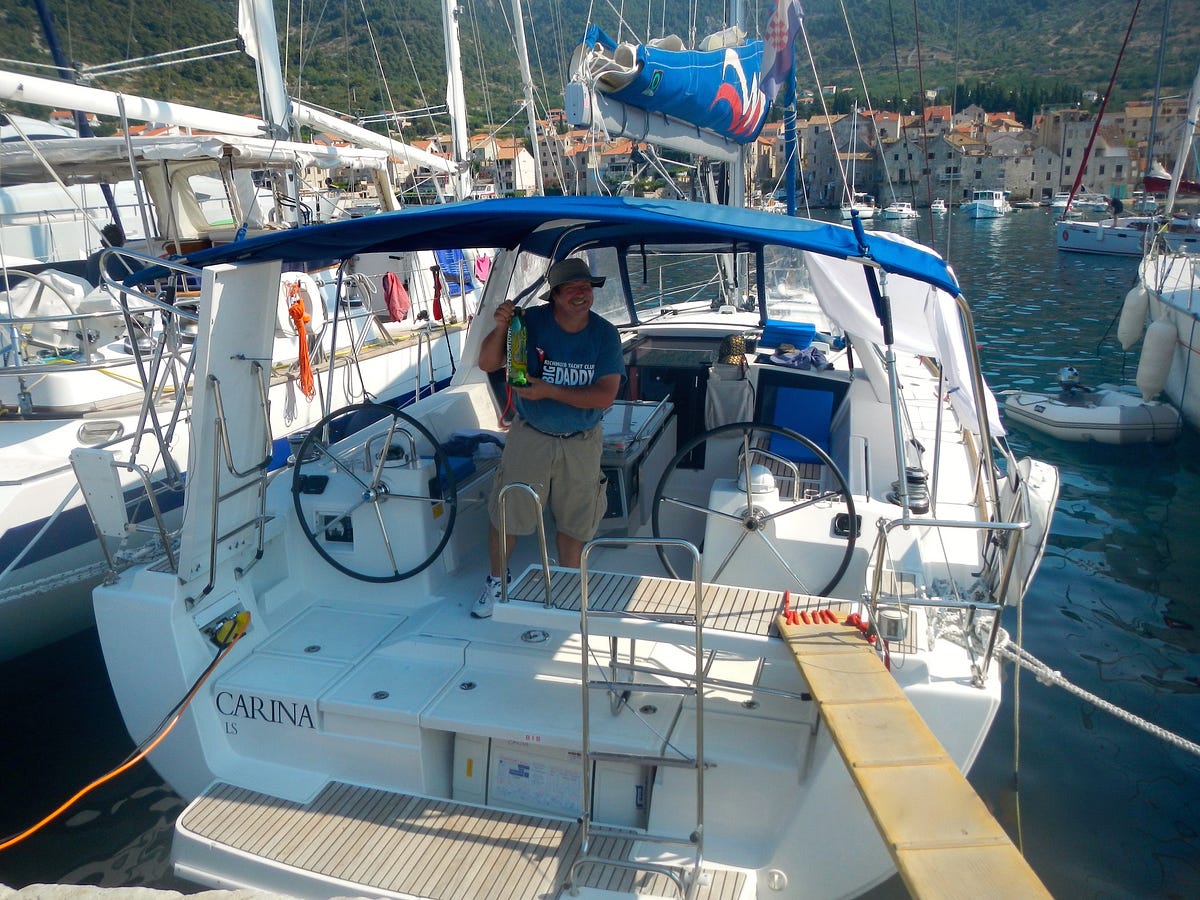
It was in Komiža that we got to try the Dalmatian specialty, peka — lamb or other meats, potatoes, carrots, onions, zucchini, drizzled with olive oil and cooked in a covered iron pot on a bed of coals, with coals piled on the lid as well. Not something I would normally think to order on a hot summer night; and you had to call the restaurant at least 3 hours ahead, as it takes every bit of that time to cook it properly. But after we had placed our order of grilled lamb chops on a waterfront patio one evening, the waiter came back to our table and asked if we would like to switch to lamb peka, as they had an order ready to serve that had been cancelled. Sure, why not? And all I can say is… if you get the chance, order it, no matter how hot the weather. Fabulous! We also had blitva — Swiss chard sautéed with potatoes, garlic & olive oil. Also wonderful, I will have to look for a good recipe when I get home. Local cheese drizzled with honey to start (gotta remember that too); house-made blackberry liqueur as a digestif… I could so get used to this.
Days 5 & 6: the quay at Stari Grad, island of Hvar: 43° 11′ 3.10″ N, 16° 35′ 34.19″ E
After a couple of days and nights enjoying the food, the beaches and the atmosphere at Komiža, it was time to move on. First up, the famous Blue Cave on the island of Biševo. We had stopped by there on the way to Komiža two days before, but the crowds on shore and the jam-packed mooring field made us think that early morning was a better choice. Especially since, if you get there early enough, you can go inside in your own dink instead of having to pay for the privilege of riding in a boat operated by a tour company. Heh heh.
After our early visit to the Blue Cave, we headed northeast to the island of Hvar. The town of Hvar, which from everything we’ve read is Party Central, didn’t call to us, but Stari Grad did: deep inside a well-protected inlet, with plenty of quay to tie up to. We were slightly disappointed in our first glimpse of the too-new waterfront — “Croatia as interpreted by Disneyland,” said Rory — but a short walk away from the quay led us into a maze of narrow alleyways, just like you would hope to see in one of the oldest cities in Europe. As for the newness around the edges of town: the bunkers lurking in the hills were all the explanation we needed. Yikes…
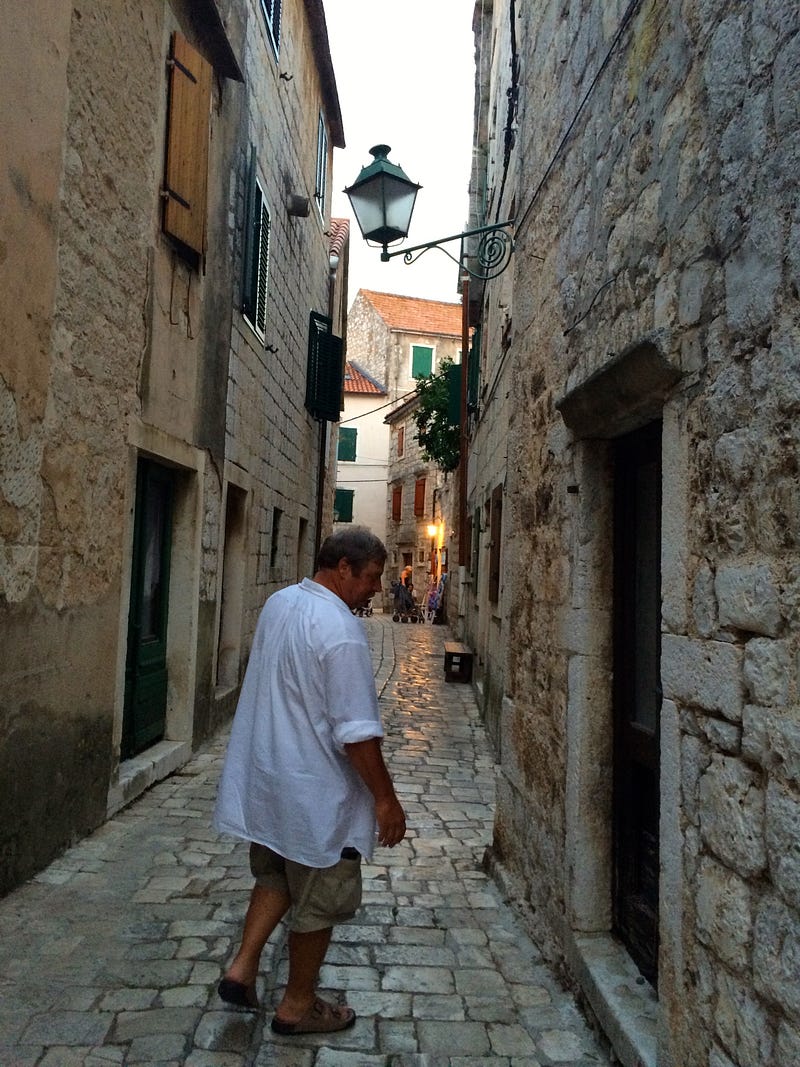
We stayed here for two nights as well, but not for lack of trying to go elsewhere. After the first night we headed north to the island of Brač, where there were dozens of little bays to duck into, and a hillside monastery that Craig and France wanted to visit. We found a tiny bay all right, perfect for lunch and a swim; but the idea of climbing these arid hills on a hot, still afternoon was — waitasec, I see stormclouds forming at the eastern end of Brač, and ominous rumbles of thunder. Is it headed our way?
After a few flashes from the darkening sky, we decided that rather than searching for a safe place to wait it out on Brač, our best choice was to head to a known harbor; so we dashed back south to Stari Grad. A good thing, too: what had been a very light breeze ramped up to strong gusts and a spattering of rain, and suddenly we were on an overpowered boat. Reef the main! furl the jib!! It was with relief that we tied back up to the city quay. That was exciting… so, who’s up for a restaurant and a ramble through town?
Day 7: Stari Grad to Marina: 43° 30′ 45.59″ N, 16° 6′ 55.74″ E
The thunderstorm of the day before was long gone leaving very light winds, so we had to motor most of the way; but we had enough time to fit in a stop at Nečujam Bay on the north side of the island of Šolta, for lunch and a good long swim in this amazing water. Didn’t want to climb back on board… But we followed the fleet back to base, and finished our Croatian cruise by nailingthe Med moor at Marina Agana. Hah!
* * *
Travel notes: Midsummer in Croatia is hot. Really hot. Our ‘travel clothes’ — pants with zip-off legs, polo shirts, teeshirts, all made of fast-drying synthetics — never got worn. Cotton and rayon were the only bearable fabrics when we weren’t swimming. No worries about stuff not drying; it was so hot that anything pinned to the lifelines was dry by nightfall.
Water shoes are essential. A sandy beach is a rarity, rounded pebbles are a gift, rough rocks are the norm. With or without sharp or squishy marine life attached. After a couple of days of fighting with flip-flops that wanted to float right off my feet, I bought water shoes from a street vendor. Classic Crocs did the trick for Rory.
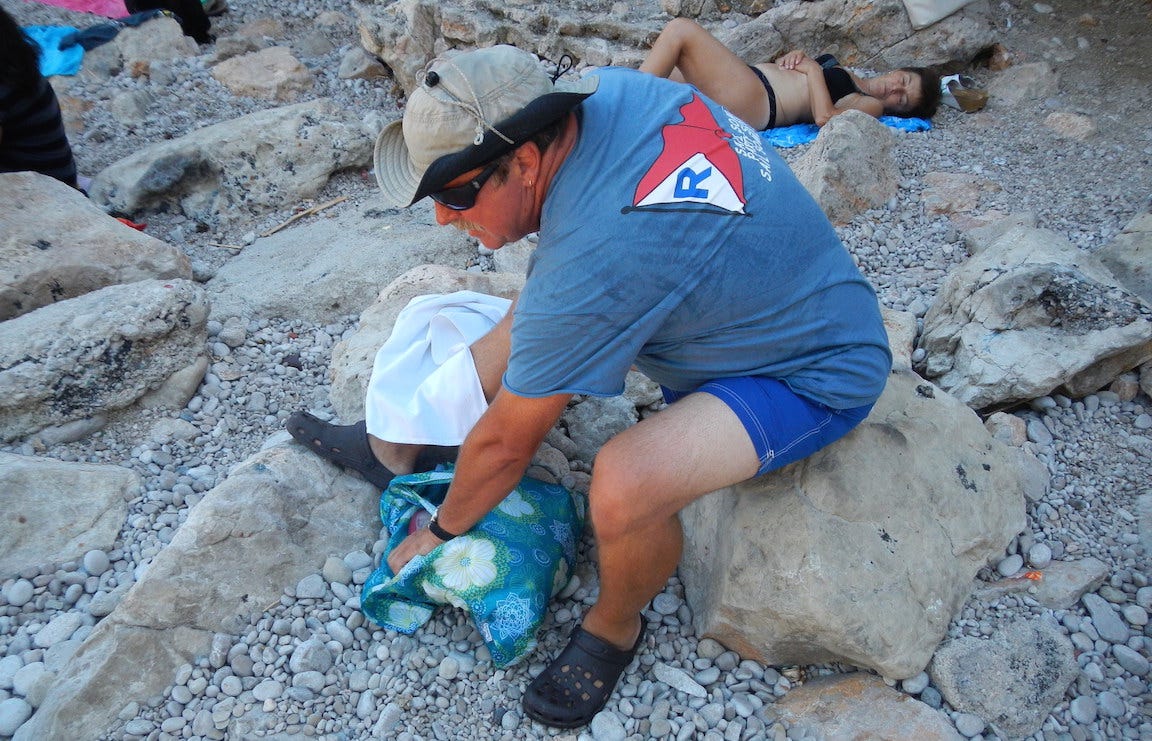
Most bays you will anchor fairly close in, as the depth drops off rapidly from shore. Little to no tidal currents in the Adriatic; recommended scope was 3:1 of the all-chain rode. We generally did not have a problem with holding, but on this rocky bottom we made a point of diving the anchor every time it was deployed. The only issue we had with any of our day anchorages was crowding — as much as you might want to check out what’s on shore, sometimes you have to accept the fact that there isn’t enough room to anchor safely.
If you want to tie up to the city quay, show up early and secure a spot well before sundown. By late afternoon, it became a bit of a circus to watch boats come into harbor and circle looking for a spot; and watch the Harbor Guys scramble to squeeze in as many boats as they could.
Equipment: If you want to get a good look at anything, bring your own binoculars — the ones on board are completely useless. Other than that, the boats were very well equipped. The cruisers’ guide 777 Harbours and Anchorages, which covers the coasts of Slovenia, Croatia, Montenegro and Albania, was tucked into the nav station along with local charts; an excellent resource. No cockpit grills in Moorings’ Croatia fleet, but one much-appreciated luxury was the portable ice maker: once we decided to spend our nights on a quay, it was in constant use.
Except for toothpaste, sunscreen, the bar of body soap/shampoo that goes everywhere with us and REI’s indispensable jungle juice (98% DEET), we are coming around to packing minimal toiletries and buying as we go. Easier to lug around in general, easier to go through airport security, and there are plenty of little stores that are happy to sell you whatever you need.
All in all, Croatia was a welcome surprise: friendly people, excellent food, and hundreds of places to explore on and off the water. We barely made a dent in the Dalmatian islands; and were nowhere near Dubrovnik and the charter bases at the southernmost tip of Croatia… Many more adventures to look forward to in this part of the world!
All photos ©2015 Peggy Droesch


